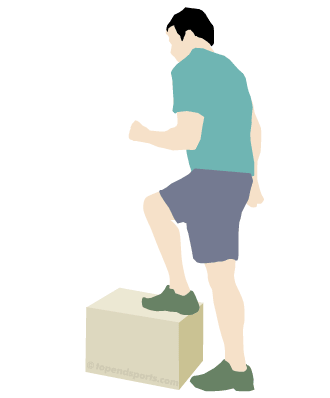The Chester Step test is a sub-maximal multistage stepping test of aerobic capacity, developed by Professor Kevin Sykes. It is a variation of a stepping type fitness tests (see other step tests), and is a test commonly used in the UK.
equipment: heart rate monitor, Chester Step software, chester step, and perceived exertion scale.
pre-test: Explain the test procedures to the subject. Perform screening of health risks and obtain informed consent. Prepare forms and record basic information such as age, height, body weight, gender, test conditions. See more details of pre-test procedures.
procedure: The step height varies for different participants (from 15cm to 25cm) based on the participant's age and physical activity history. The initial step rate is 15 steps per minute and every two minutes the tempo increases by 5 steps per minute. The stepping rate is set by a recorded metronome and guided verbal instructions, which are played on a cassette tape or compact disc. When the subject reaches 80% of age estimated heart rate maximum and/or an RPE of 14 on Borg’s 6–20 scale, they are told to stop the test.
 Step Height: The step height varies for different participants - there are standardized criteria for choosing a step height based on the participant's age and physical activity history. You can buy them here.
Step Height: The step height varies for different participants - there are standardized criteria for choosing a step height based on the participant's age and physical activity history. You can buy them here.
- 15cm/6inch - suitable for those over 40 years of age who take little or no regular physical exercise and for those over-40's who are moderately overweight.
- 20cm/8inch - suitable for those under 40 years of age who take little or no regular physical exercise and for those under-40's who are moderately overweight.
- 25cm/10inch - suitable for those over 40 years of age who take regular physical exercise and are used to moderately vigorous exertion.
- 30cm/12inch - suitable for those under 40 years of age who take regular physical exercise and are used to moderately vigorous exertion.
advantages: minimal equipment is required and the test is very portable. The test is designed to be flexible in assessing people with a wide range of absolute aerobic fitness levels by having adjustable step heights.
disadvantages: for some groups, participants may not honestly gage their Rate of Perceived Exertion for various reasons such as saving face among peers. If the step height is not adjusted for subject age and physical activity, as is sometimes done, then shorter stature participants may be at a disadvantage.
history: The Chester Step test was developed by Kevin Sykes while at Chester College – a College of the University of Liverpool, and was developed to assess aerobic fitness in fire brigades in Britain, Europe, USA, and Asia.
references
- Sykes K. Chester step test; resource pack (Version 3). Cheshire, UK: Chester College of Higher Education, 1998.
- J P Buckley, J Sim, R G Eston, R Hession, R Fox, Reliability and validity of measures taken during the Chester step test to predict aerobic power and to prescribe aerobic exercise. Br J Sports Med 2004;38:197–205.
- Sykes K and Roberts A, The Chester step test—a simple yet effective tool for the prediction of aerobic capacity, Physiotherapy, Volume 90, Issue 4, December 2004, Pages 183-188.
Similar Tests
- Other Step Tests
- Chester Treadmill Police Walk Test — walking at 6 km/hr on a treadmill, increasing gradient by 3% every 2 minutes.
- Chester Treadmill Police Run Test — run at 10.4 km/hr on a treadmill, increasing the gradient every 2 minutes.
- Chester Treadmill Test — walking at 6.2 km/hr on a treadmill, increasing the gradient by 3% every 2 minutes.
Related Pages
- About a Step Test iphone app
- Step up exercises at the beach or during pregnancy
- More information on measuring heart rate and the perceived exertion scale
- About Kevin Sykes


 Current Events
Current Events